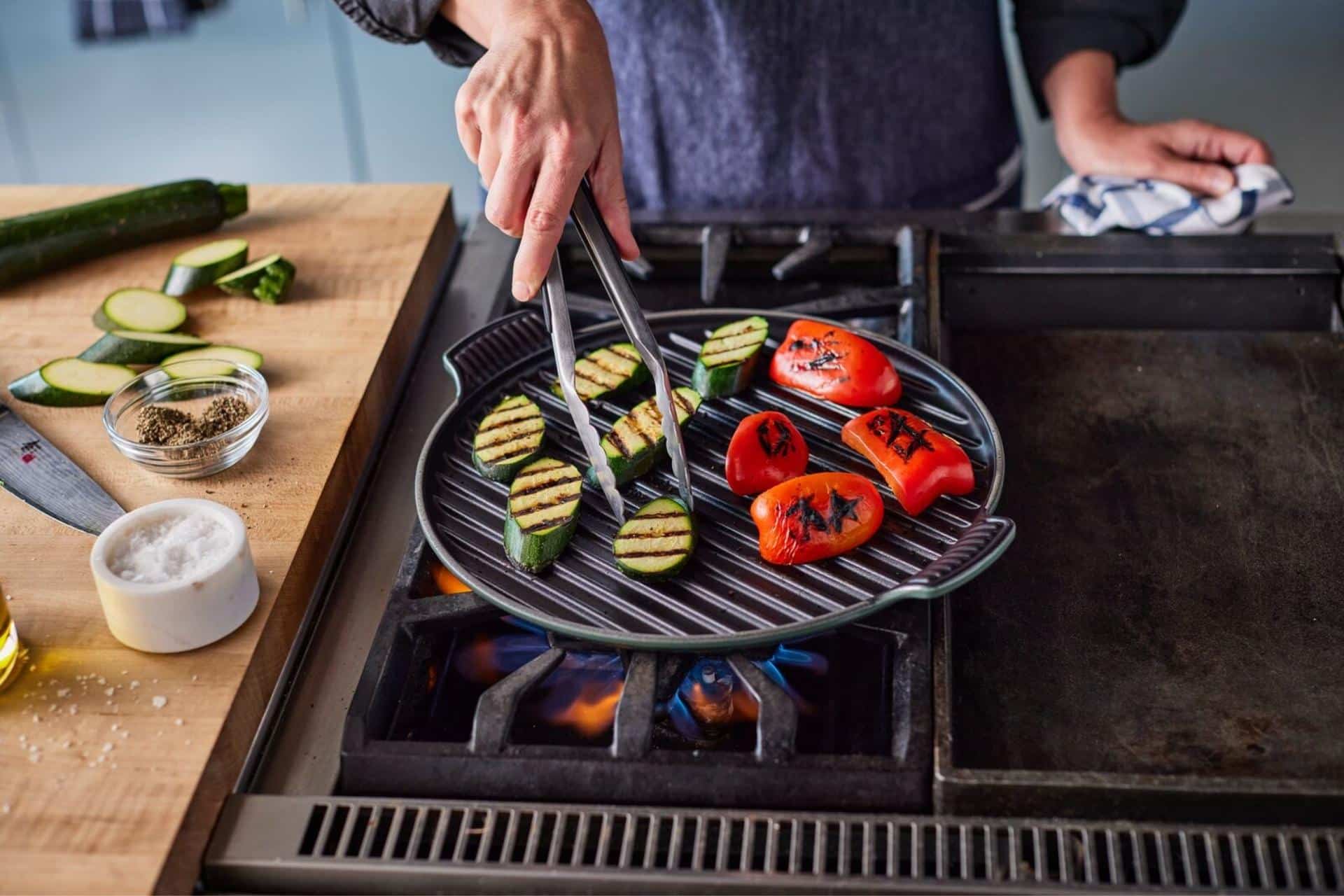Decisions, decisions.


Originally published August 2022. Updated May 2023.
If you’ve ever ordered a steak at a steakhouse, you’ve likely marveled at its beautiful, masterfully developed char marks. Those marks give the meat the distinctive smoky, caramelized flavor we love.
But if you don’t have access to a grill, you’re probably wondering—how can I get that same look and flavor at home? Three words: stovetop grill pan.
If you haven’t used a stovetop grill pan before, they’re a game-changer for those without access to a grill. They give you those same expertly crafted grill marks and caramelization. And if that’s not enough to make you want to run out and grab one, we’ve got 5 more reasons why you should get a stovetop grill pan for your kitchen.
Hungry for more? Whether you’re dining al fresco or whipping up a masterful meal indoors, you need the right tools—explore our collection of grill pans and griddles to find the one that’s right for you.
When it comes to grill pans, there are a few different types available on the market.
Grill pans are typically made of cast iron or enameled cast iron and can either be flat, made with wide walls and handles like a skillet or made reversible with a griddle on one side. Some are made of stainless steel or aluminum, and some contain nonstick coatings (including ceramic). Here’s an overview of some common types of grill pans:
Cast iron grill pans are popular due to their excellent heat retention and even distribution. They are known for creating crisp grill marks and great sears, adding a little extra flavor to the food.
Cast iron pans do require proper seasoning and maintenance to prevent rust and maintain their nonstick surface, but they’re relatively easy to care for. They’re also super durable and can withstand high heat, making them suitable for a variety of cooking methods, including stovetop grilling, stovetop-to-oven recipes and even using on your grill.
Nonstick grill pans are made with a coating that prevents food from sticking to the surface. This type of pan is easy to clean and requires less oil or fat for cooking.
Nonstick pans are ideal for delicate foods like fish and vegetables. However, they may not achieve the same level of sear and grill marks as cast iron pans. Also, it’s important to use utensils that won’t scratch the nonstick coating to maintain its longevity.
Many nonstick grill pans are made of an aluminum base, which offers excellent heat conductivity and makes them lightweight—not to mention easy to handle and maneuver.
Stainless steel grill pans offer durability and a sleek appearance. They heat up quickly and distribute heat evenly, ensuring consistent cooking results.
Stainless steel pans are known for their versatility, as they can be used on various stovetop types and in the oven. One drawback is that they don’t retain heat as well as cast iron pans, and they require a little more preparation and technique to ensure food doesn’t stick to them.
Some grill pans come with a matching lid or a detachable cover. The lid helps to trap heat and moisture, creating a more oven-like environment for cooking. It can be beneficial for achieving a more tender and evenly cooked result, especially for thicker cuts of meat, as well as anything that requires steaming (which is great for fish and veggies).
Ultimately, the type of grill pan you choose depends on your personal preferences, cooking style and budget. Each type offers its own set of advantages, so consider your needs and desired cooking outcomes when selecting the grill pan that suits you best.
There are several reasons to consider adding a stovetop grill pan to your kitchen collection.
The biggest benefit of a stovetop grill pan is getting those coveted grill marks. And those things aren’t just for show—those grill marks impart a very distinct smoky, caramelized flavor to food.
This is called the Maillard reaction, and to get it to kick in, you want a surface hot enough to activate the enzymes that cause it. The trick is to preheat the grill pan before adding the meat or vegetables, then let your food rest in one spot as the grill marks form.
When cooking meat, rotate it 90 degrees halfway through the cooking time on each side so that you heat it evenly and generate cross-hatched grill marks.
When you cook food on the grill, any extra fat or oil is cooked out of it and drips between the grates and off your food.
You can get the same effect (mostly) from a grill pan. The elevated ridges on a stovetop grill pan make direct contact with the food, and the space between the ridges allows for airflow. This allows steaks and burgers to cook with a drier heat and prevents them from poaching in their own fat.
Grill pans are incredibly versatile.
Some come with long handles similar to those of a skillet and are used in very much the same way. These are great for recipes that call for cooking items in the oven and finishing them on the grill. And, if you have limited space, these are roughly the same size as a medium-large cast iron pan, which makes storage a breeze.
Other grill pans are reversible and are made with a smooth, flat surface on one side, often called a griddle. These are ideal for, well, most everything—pancakes, bacon, burgers, shrimp, even toasting some bread! They’re made to be placed on top of your stove, using the heat from the burners to cook the food. This will allow for more control when cooking, as the space directly above the burners gets hot and the space between remains cooler, allowing you to move food around to prevent overcooking.
One thing to note: if you have an induction cooktop, you’ll want to look for a grill pan made from an induction-safe material, such as cast iron. Watch out for items made from copper, aluminum or glass, as they won’t work on their own.
Grill pans are usually heavier than skillets and are typically made from materials that heat up quicker and retain heat longer, like cast iron.
This means you’re less likely to get cold spots while cooking (with the exception of stovetop griddles that develop cold spots between burners), and you’ll have more control over the temperature to ensure food is cooked the way you like it.
A lot of people see the ridges on a grill pan and immediately think: “Oh no, this is going to be so hard to clean!” But if you’re ever in a pinch, here’s a helpful tip for cleaning your grill pan:
After you remove the food from the pan, pour a small amount of hot water into it. Using tongs and a clean dishrag, move the sizzling water around and pick up the food particles that are stuck to the surface. If you do this while the pan is piping hot, you can pick up any food particles that may be cooked on or hard to remove.
If you’re looking to add to your kitchen collection—or perhaps you’re wanting to grill but don’t have access to an outdoor space—the first thing you’ll want to do is give your new stovetop grill pan a try! Here are some of our favorite stovetop grill recipes to get started with:
Hungry for more? Whether you’re dining al fresco or whipping up a masterful meal indoors, you need the right tools—explore our collection of grill pans and griddles to find the one that’s right for you.
JOIN THE CONVERSATION